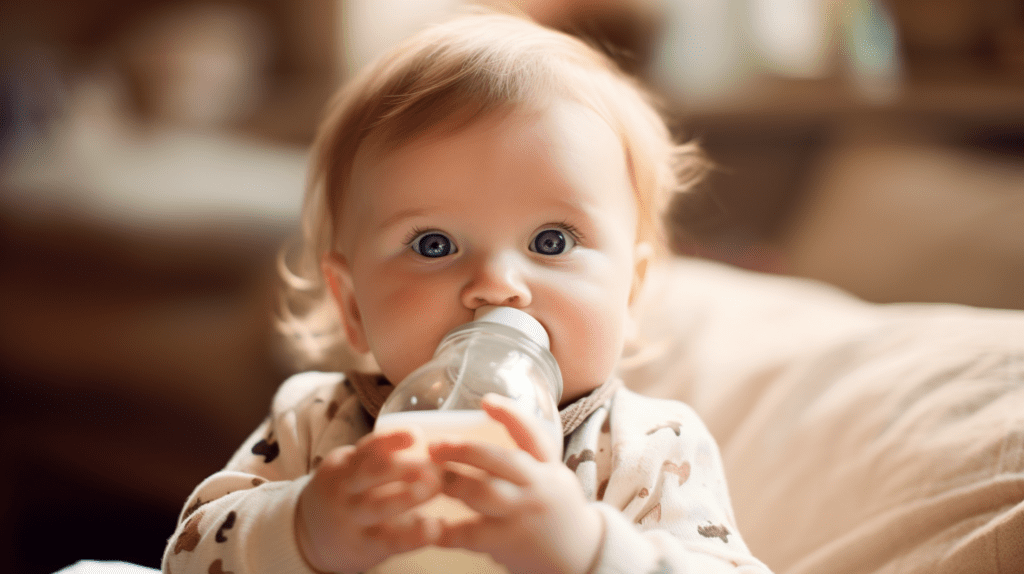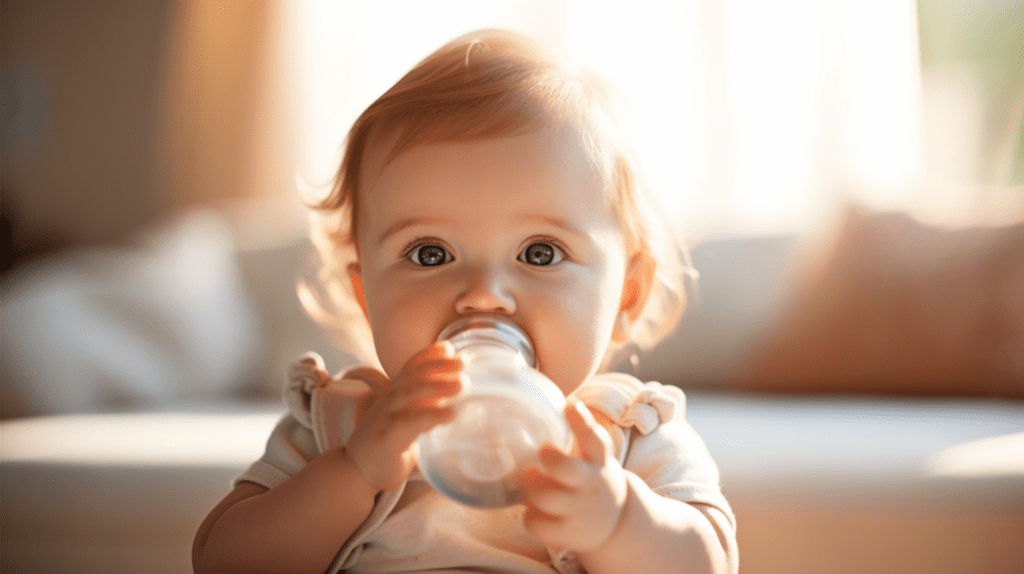Feeding your baby can be one of the new parents’ most rewarding and challenging experiences. While breastfeeding is a natural and recommended way to nourish your baby, it may not always be possible or desirable. Bottle feeding can be a great alternative or supplement to breastfeeding, allowing other family members to bond with your baby and giving you more flexibility in your schedule.
However, bottle feeding comes with its own set of challenges, including choosing the right bottle and nipple, preparing and storing formula, and ensuring your baby is getting the proper nutrition and amount of milk. This guide will provide tips and advice for successful bottle feeding, covering everything from selecting the right bottle to troubleshooting common issues. Whether you are a new parent or an experienced caregiver, this guide will help you navigate the world of bottle feeding and ensure a positive feeding experience for you and your baby.
Bottle Feeding Breast Milk

Bottle feeding breast milk is typical among new mothers who want to supplement breastfeeding or switch to bottle feeding entirely. Breast milk is an ideal source of nutrition for babies and has numerous health benefits. Here are some tips for bottle-feeding breast milk:
Choose the right bottle
Select a bottle with a slow-flow nipple to mimic the slower flow of breast milk during breastfeeding. Also, choose a bottle with a wide neck for easy cleaning.
Pump and store breast milk properly
Use a breast pump to express milk and store it in a clean, sterile container. Breast milk can be stored in the refrigerator for up to five days or in the freezer for up to six months.
Warm breast milk
Heat the breast milk by placing the bottle in a container of warm water. Avoid microwaving breast milk as it can cause hot spots and destroy the nutrients in the milk.
Practice responsive feeding
Pay attention to your baby’s hunger cues and feed them on demand. Offer the bottle when the baby is showing signs of hunger, such as sucking on their hands or crying. Don’t force the baby to finish the entire bottle if they show signs of fullness.
Burp the baby
After feeding, burp the baby by holding them upright and gently patting or rubbing their back. This can help release any air trapped in their stomach and prevent discomfort or spit-up.
Clean and sterilize the bottle
After each use, wash the bottle and nipple with warm, soapy water and sterilize them using a sterilizer or boiling water.
Bottle feeding breast milk can be a convenient and healthy option for mothers and babies. However, it’s important to note that breast milk is still the best source of nutrition for babies, and exclusive breastfeeding is recommended for the first six months of a baby’s life. If you have concerns or questions about bottle-feeding breast milk, consult a lactation consultant or healthcare provider.
Formula Options
Formula options can be overwhelming for new parents. Formula options include cow’s milk-based formula, soy-based formula, hypoallergenic formula, and organic formula.
Cow’s milk-based formula is the most common and is suitable for healthy, full-term babies without allergies or digestive issues. Soy-based formula is an alternative for babies with lactose intolerance or difficulty digesting cow’s milk-based formula. Hypoallergenic formula is designed for babies with milk or other food allergies. Organic formula is made from organic ingredients and is free from pesticides, hormones, and harmful substances.
When choosing a formula for your baby, you must talk to your pediatrician or a registered dietitian to determine the best option for your baby’s needs. Your baby’s age, health, and any existing allergies or medical conditions should be considered when choosing a formula.
Choosing the Right Bottle

Choosing the right bottle for your baby can make a big difference in their feeding experience. With so many options available, deciding which one to choose can be overwhelming. Here are some factors to consider when selecting a bottle:
Material
Bottles come in various materials, including glass, plastic, and silicone. Glass is durable and easy to clean but can break if dropped. Plastic is lightweight and less likely to break, but it can scratch over time and harbor bacteria. Silicone is a newer material that is durable, lightweight, and easy to clean, but it can be more expensive.
Shape and Size
Bottles come in different shapes and sizes. Some are tall and narrow, while others are short and wide. Some have angled necks to make feeding more comfortable for you and your baby. The bottle size will depend on your baby’s age and feeding needs.
Nipple Type
The nipple is an integral part of the bottle, as it determines the milk flow and can affect your baby’s feeding experience. Nipples come in different shapes, sizes, and materials, such as silicone or latex. Some nipples have a slow flow, which is ideal for newborns, while others have a faster flow for older babies. It may take some trial and error to find the right nipple for your baby.
Anti-Colic Features
Some bottles are designed with anti-colic features, such as venting systems or angled shapes, to reduce the amount of air your baby ingests while feeding. This can help prevent colic and gas, which can be uncomfortable for your baby.
By considering these factors and experimenting with different bottles, you can find the right one for your baby’s needs and preferences. Always inspect the bottle for cracks or damage before use, and clean and sterilize it properly to prevent bacteria growth.
Sterilizing Bottles
Before using a new bottle for the first time, sterilizing it is important to kill bacteria or germs. You should also sterilize bottles after each use until your baby is at least 6 months old, or as your pediatrician recommends. Here are some methods for sterilizing bottles:
Boiling
Place the bottle, nipple, and any other parts in a large pot of boiling water for at least 5 minutes. Make sure all parts are completely submerged and there are no air bubbles.
Steam sterilizer
Use an electric steam sterilizer or microwave steam bag per the manufacturer’s instructions.
Chemical sterilizer
Use a chemical sterilizing solution or tablet according to the manufacturer’s instructions.
Preparing Formula
Preparing formula for your baby is crucial in ensuring their health and safety. First, ensure you have all the equipment, including bottles, nipples, and a formula mixing pitcher. Wash your hands thoroughly before handling any of the equipment.
Next, fill the pitcher with the correct amount of water and add the appropriate amount of formula powder according to the instructions on the package. Mix the formula thoroughly until all the powder is dissolved.
Once the formula is mixed, you can pour it into the baby’s bottle. Make sure to test the temperature of the formula on the inside of your wrist before feeding your baby. If it is too hot, let it cool down before feeding.
Any unused formula should be discarded after one hour at room temperature or after 24 hours if refrigerated. Always follow the instructions on the formula package for proper storage and use.
Storing Bottles and Formula
Bottles and formula should be stored properly to prevent bacteria growth and spoilage. Here are some tips for storing bottles and formula:
- Store the prepared formula in the refrigerator and use it within 24 hours. Discard any formula that has been left out for more than an hour.
- Store the unopened formula in a cool, dry place and use it before the expiration date.
- Store bottles and nipples in a clean, dry place after sterilizing and before use.
Following these steps, you can ensure that your baby’s bottles are sterilized and prepared properly for a safe and healthy feeding experience.
Feeding Positions

The position you hold your baby in while bottle feeding can make a big difference in their comfort and digestion. Here are some common feeding positions:
Cradle hold
Hold your baby in your arms, with their head resting in the bend of your elbow and their body facing you.
Football hold
Hold your baby with their head in your hand, and their body tucked under your arm like a football.
Side-lying position
Lie down on your side with your baby facing you, and feed them while they lie beside you.
No matter which position you choose, ensure your baby’s head and neck are supported and comfortable. You can use a nursing pillow or a rolled-up blanket to help support your baby’s body. Additionally, make sure the bottle is tilted so that the milk is always covering the nipple to prevent your baby from swallowing air.
Signs of Hunger and Fullness
Newborn babies have small stomachs, so they need to feed frequently, typically every 2-3 hours. As your baby grows, they may start to go longer between feedings. However, it is important to pay attention to your baby’s hunger cues and feed them when they are hungry. Some signs of hunger in newborns include rooting (turning their head towards something when it touches their cheek), sucking on their hands or fingers, and fussiness.
It is also important to watch for signs of fullness to ensure that your baby is not overfed. Some signs of fullness include slowing down or stopping sucking, turning their head away from the bottle, spitting out the nipple, and falling asleep. It is recommended to not force your baby to finish the bottle and instead offer the bottle again when they show signs of hunger.
It is important to note that every baby is different and may have their own unique hunger and fullness cues. By paying attention to your baby’s behavior during feeding and learning their individual cues, you can help ensure they are getting the appropriate amount of nutrition.
Frequency and Amount of Feedings
The frequency and amount of feedings can vary depending on your baby’s age and feeding habits. Here are some general guidelines:
Newborns (0-4 months)
- Feed on demand: Newborns typically need to eat every 2-3 hours or 8-12 times daily.
- Formula: Most newborns will consume around 1-3 ounces (30-90 mL) per feeding, but this can vary.
- Breastfeeding: Newborns may nurse for 10-15 minutes on each breast, but this can also vary.
Infants (4-6 months)
- Feed on demand: Infants may still need to eat every 2-3 hours or 6-8 times daily.
- Formula: Infants may consume 4-6 ounces (120-180 mL) per feeding.
- Breastfeeding: Infants may nurse for 15-20 minutes on each breast.
Older infants (6-12 months)
- Formula: Older infants may consume 6-8 ounces (180-240 mL) per feeding, usually 4-6 times daily.
- Solid foods: As your baby begins to eat solid foods, they may begin to nurse or drink less milk.
It’s important to remember that these are just general guidelines and every baby is different. Some babies may eat more or less than these amounts, and some may need to eat more frequently. It’s essential to listen to your baby’s hunger cues and feed them on demand.
Additionally, it’s essential to avoid overfeeding your baby. Overfeeding can lead to discomfort, spitting up, and even obesity. Don’t force your baby to finish a bottle or breastfeed if they show signs of fullness. Instead, let them take breaks and feed at their own pace.
If you have concerns about your baby’s feeding habits or feel like they are not getting enough milk, speak with your pediatrician. They can provide guidance and support to help you and your baby get the necessary nutrition.
Burping and Spit-up
Burping is important to help your baby release any swallowed air during feedings, which can lead to discomfort or spit-up. To burp your baby, hold them upright against your chest or lap, gently pat or rub their back. You can also try sitting them upright and supporting their chin with one hand while gently patting their back with the other hand.
If your baby spits up frequently, try feeding them in an upright position and taking breaks during the feeding to burp them. You can also try smaller, more frequent feedings to help reduce spit-up. If you are concerned about the amount or frequency of spit-up, talk to your pediatrician.
Remember, every baby is different and may require different burping and managing spit-up techniques.
Nighttime Feedings
Nighttime feedings can be especially challenging for new parents, as they often disrupt sleep and can be exhausting. If you are struggling with nighttime feedings, there are some strategies you can try to make the process easier.
One option is to consider hiring a Night Nanny. A Night Nanny is a trained professional who can help with nighttime feedings, diaper changes, and other baby care tasks while you get some much-needed rest. They can also provide guidance on feeding and sleep schedules to help establish healthy habits for both you and your baby.
If hiring a Night Nanny is not an option, you can still do some things to make nighttime feedings more manageable. First, try to establish a consistent feeding schedule during the day to help regulate your baby’s hunger cues. This can help reduce the number of nighttime feedings your baby requires.
Next, consider using a side-lying nursing position or a laid-back breastfeeding position to make nighttime feedings more comfortable for both you and your baby. You can also keep a nightlight in your baby’s room to help you see what you’re doing without fully waking yourself or your baby.
Finally, be sure to take care of yourself by getting as much rest as possible during the day and enlisting help from family and friends when you need it. Remember, it’s important to prioritize your own health and well-being in order to provide the best possible care for your baby.
Troubleshooting
Bottle feeding can be a wonderful bonding experience between parents and their baby, but it’s not always easy. Some challenges may arise when bottle feeding, and it’s important to be prepared to troubleshoot these issues. Here are some common problems that parents may encounter when bottle feeding their baby and some possible solutions:
Nipple Confusion
Sometimes babies can struggle with latching onto the bottle nipple, especially if they have been breastfed as well. This is known as nipple confusion, and it can make bottle feeding difficult. If your baby is having trouble latching onto the bottle, try different nipple shapes and sizes to find one that your baby is comfortable with. Also, make sure the flow of the milk is appropriate for your baby’s age and feeding abilities.
Colic
Colic is a condition that can cause babies to cry excessively and be irritable, often for several hours a day. It’s not clear what causes colic, but some babies may be more prone to it than others. If your baby is experiencing colic, try holding them in a different position during feedings, such as upright, and make sure they are burping frequently. Additionally, try feeding your baby smaller, more frequent meals to help ease their discomfort.
Spit-Up
It’s common for babies to spit up a small amount of milk during or after feedings. However, if your baby is consistently spitting up large amounts of milk or seems to be in pain, it may be a sign of a more serious problem such as reflux. To minimize spit-up, ensure your baby is upright during feedings and try burping them frequently. Also, consider feeding your baby smaller amounts more frequently to help them digest the milk more easily.
Refusal to Eat
Sometimes babies may refuse to eat, which can be concerning for parents. If your baby refuses to eat, it may be a sign that they are not hungry or experiencing discomfort. Make sure your baby is not too hot or too cold and that their diaper is clean. If your baby continues to refuse to eat, contact your pediatrician for guidance.
Every baby is unique and may have different feeding needs and preferences. If you’re struggling with bottle feeding, don’t hesitate to reach out to your pediatrician or a lactation consultant for support and guidance. With patience and persistence, you can develop a successful bottle feeding routine that works for you and your baby.
Weaning from the Bottle
Their feeding needs and habits will change as your baby grows and develops. One of the most significant changes is the transition from bottle feeding to drinking from a sippy cup or regular cup. This process can take time and patience, and it is important to start introducing cups to your baby around 6-9 months of age.
Introducing a sippy or regular cup to your baby at an early age can help them get used to drinking from something other than a bottle. It can also help prevent the habit of prolonged bottle use, which can lead to dental problems or other issues.
At around 6 months of age, you can start offering your baby a sippy cup or training cup during meal times. Initially, you may want to offer a small amount of water or formula in the cup and let your baby play with it and get used to the feel of it. Gradually increase the amount of liquid you offer in the cup and decrease the amount in the bottle.
Around 9-12 months of age, your baby may be ready to start drinking from a regular cup with some assistance. Choose a small, lightweight cup with handles that your baby can easily grasp. You may want to start with a few sips of water or formula in the cup and gradually increase the amount over time.
It is important to remember that every baby is different, and some may take longer to transition to drinking from a cup than others. Be patient and consistent in your efforts, and try different types and styles of cups to find one that your baby is comfortable with.
Remember that transitioning from the bottle to a cup is an important milestone in your baby’s development, and it can take time and patience to make the transition successfully. Start early, be consistent, and offer your baby plenty of encouragement and support throughout the process.
Conclusion
Bottle feeding can be an excellent option for new moms who cannot breastfeed or choose not to. With the right preparation, equipment, and knowledge, bottle feeding can provide a safe, convenient, and nourishing way to feed your baby.
At Motherhood Center in Houston, TX, we understand the challenges and joys of motherhood. That’s why we offer a wide range of services and resources to support new moms, including lactation consultations, educational classes, and a supportive community of other moms.
If you’re struggling with bottle feeding or have questions about your baby’s feeding habits, our team of lactation consultants can provide personalized support and advice to help you navigate the challenges of motherhood. Contact us today to learn more about our services and how we can support you on your motherhood journey.
FAQs
How often should I sterilize my baby’s bottles?
It’s recommended to sterilize your baby’s bottles before the first use and periodically thereafter. Some parents choose to sterilize bottles after each use, while others opt to sterilize them once a day or a few times a week. Follow the manufacturer’s instructions for your bottle and sterilizer, and consult with your pediatrician if you have any concerns.
What formula is best for my baby?
There are many different formulas available, and the best one for your baby will depend on their specific needs and any allergies or sensitivities they may have. Talk to your pediatrician about which formula they recommend for your baby, and make sure to follow the instructions carefully when preparing it.
How do I know if my baby is getting enough to eat?
Pay attention to your baby’s feeding cues, such as rooting or smacking their lips. A general rule of thumb is that newborns need to eat every 2-3 hours and should have around 2-3 ounces per feeding. However, every baby is different, so consult with your pediatrician if you have any concerns about your baby’s feeding habits or weight gain.
What’s the best way to burp my baby?
There are several ways to burp your baby, including over your shoulder, sitting them upright and patting their back, or laying them on their tummy and patting their back. Experiment with different positions to find what works best for your baby. Make sure to burp them frequently during feedings and after to reduce the likelihood of spit-up.
How do I wean my baby off the bottle?
Gradual weaning is typically recommended, where you slowly reduce the number of bottles your baby has per day and replace them with a cup. Start by introducing a sippy cup around 6-9 months of age, and encourage your baby to drink from it during meals. Over time, you can decrease the number of bottles and increase the amount of time your baby spends drinking from a cup. Remember to be patient and provide plenty of positive reinforcement along the way.



